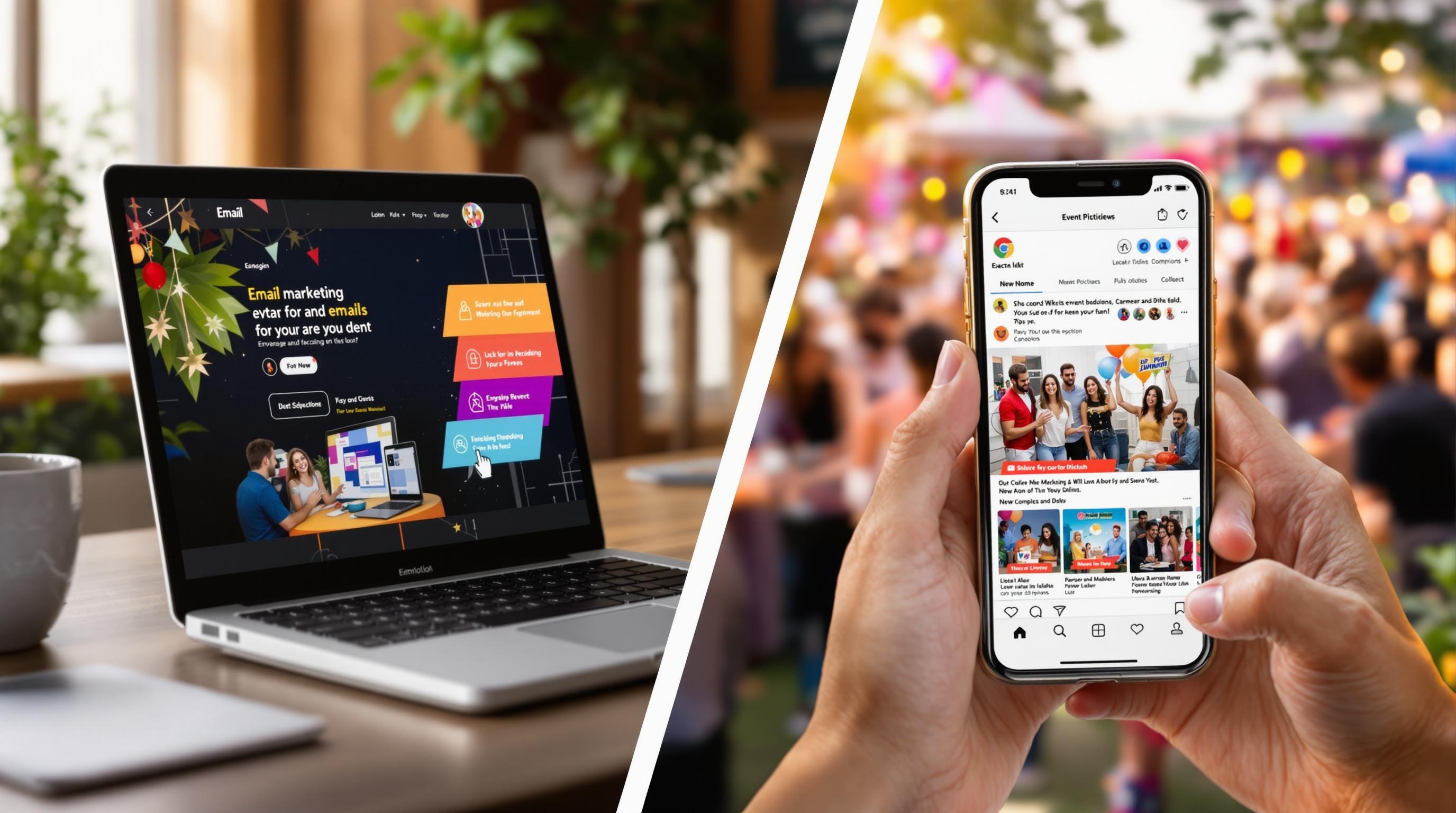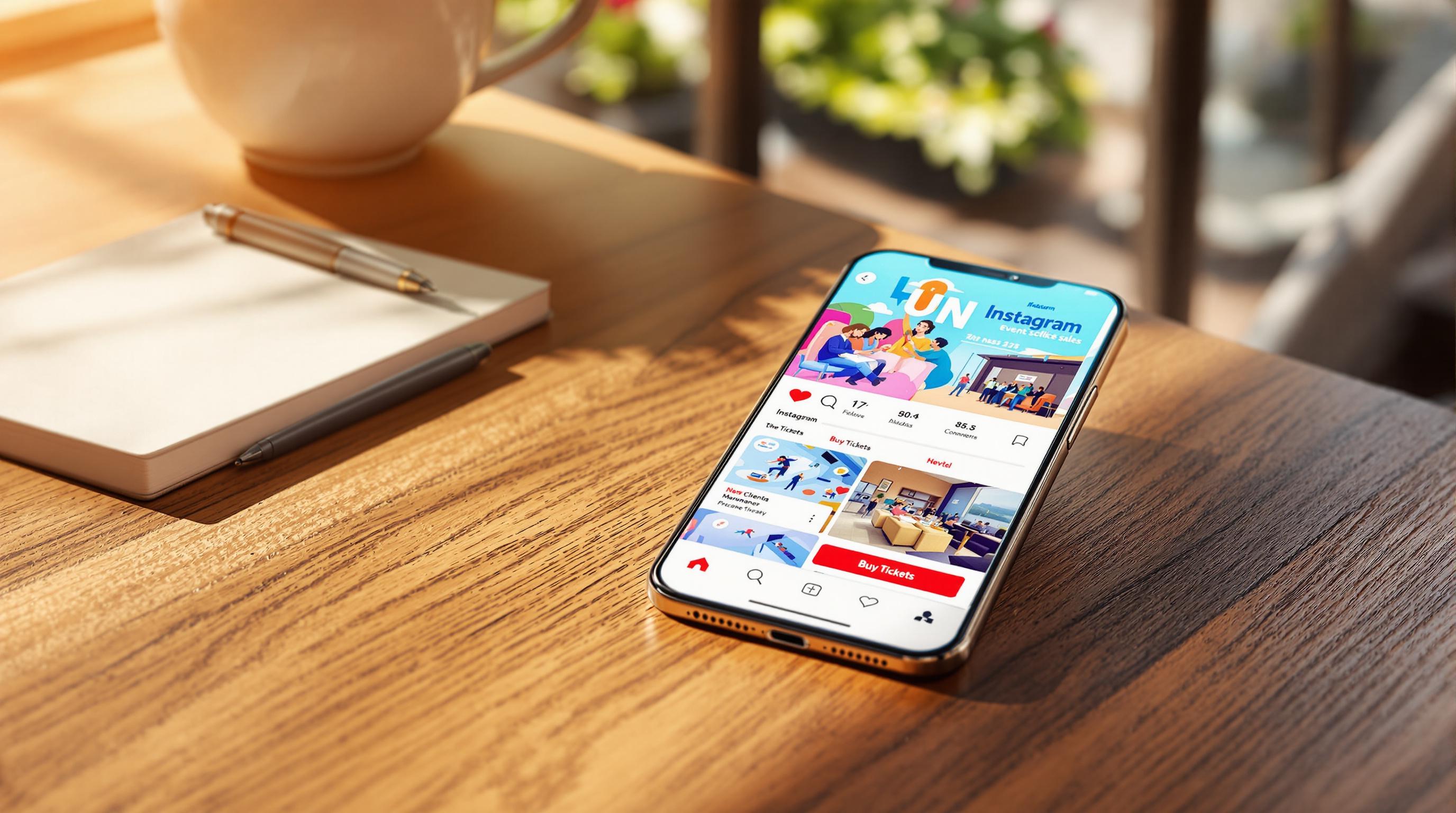Want to boost ticket sales and engage your audience directly? Newsletters are your secret weapon. Unlike social media, newsletters let you bypass algorithms, personalize content, and track performance. Here’s a quick overview of the most effective strategies:
- Write Better Subject Lines: Keep them short, personalized, and action-oriented to increase open rates.
- Segment Your Audience: Tailor content based on roles, interests, and engagement levels for better results.
- Send at the Right Time: Weekdays (9 AM–1 PM) work best, but test what works for your audience.
- Use Photos & Videos: High-quality visuals can double engagement.
- Optimize Call-to-Action (CTA) Buttons: Make them clear, visible, and mobile-friendly.
- Personalize Content: Align messages with the specific needs of your audience.
- Show Past Event Success: Highlight metrics, testimonials, and achievements to build credibility.
- Design for Mobile: Ensure emails are easy to read and interact with on phones.
Why It Works
By combining these tactics, event organizers have seen up to a 50% increase in revenue and significant boosts in attendance. Start implementing these strategies to grow your events and build lasting connections with your audience.
Related video from YouTube
1. Write Better Email Subject Lines
Your email subject line plays a major role in event promotion. With nearly half (47%) of recipients opening emails based on the subject line alone, getting it right can directly boost engagement and ticket sales.
Keep subject lines under 50 characters to ensure they display properly on mobile devices. Instead of generic phrases like "Event Update", make them specific and enticing.
Here are some tips to craft better subject lines:
- Personalize your message: Add the recipient's name or mention their past attendance. For example, a vFairs mixer in Nashville saw a 33.33% open rate by personalizing their emails.
-
Create urgency: Use FOMO (fear of missing out) sparingly but effectively. As Katarina Andrejević from Userlist points out:
"The FOMO approach has its perks, but only if we don't overuse it, make it timely, and communicate the value. If you overuse the whole 'last-minute' shtick, the leads will grow numb to the next offer, and it won't really feel like they're missing out on anything."
- Use action-oriented language: Strong verbs and personalization can drive responses.
Adding numbers or emojis can also make your subject lines stand out. Subject lines with numbers average a 20% open rate, and those with emojis perform 60% better than plain text.
Here are a few examples of effective subject lines:
- Event Value: "Double Your Network at Tech Mixer" – Clearly communicates a benefit
- Time Sensitivity: "48 Hours Left: Early Bird Pricing Ends" – Encourages immediate action
- Social Proof: "Join 500+ Marketing Leaders at Summit" – Establishes credibility
"Crafting compelling event email subject lines is crucial in the fast-paced world of event planning and marketing. It's the first point of contact with your attendees, acting as the make-or-break factor for your email open rates."
Don't forget to A/B test your subject lines. Testing variations in length, tone, and personalization can improve ROI by up to 28%. Experiment to find what resonates best with your audience.
2. Split Your Email Lists by Audience Type
Breaking your email lists into specific categories allows you to send content that resonates with different groups of attendees. Research shows that segmented email campaigns can increase customer lifetime value by as much as 33%. Lauren McCullough, VP of Marketing at Bizzabo, highlights the importance of this approach:
"Classifying email recipients through different categories ensures the most relevant and personalized reading experience for the attendee."
Here are some practical ways to segment your event email lists:
- By Role and Interest: Adjust content for speakers, sponsors, and general attendees. Use session sign-up data to guide your messaging. For example, Cvent's December 2024 feature can automatically sort audiences based on their activities.
- By Engagement Level: Group subscribers into active, occasional, and inactive categories. This helps you craft messages that match their level of interaction.
- By Registration Status: Focus on 'almost-attendees' who started but didn’t finish registration. Send follow-ups with tailored content to encourage them to complete the process.
- By Past Event Experience: Separate first-timers, returning participants, and VIPs based on past event interactions and satisfaction scores. This lets you create content that speaks to their unique experiences.
- By Geographic and Time Zone: Consider location when scheduling emails. Use region-specific details, like event logistics, and send messages at times that align with the recipient’s time zone.
Personalization matters - a whopping 90% of top marketers say it directly affects profitability. Tools like MailerLite and Mailchimp make segmentation easier with advanced features designed for this purpose.
For sponsors and exhibitors, create segments based on sponsorship levels. This allows you to share details like booth locations, setup times, and promotional opportunities.
Make sure to review and update your segments regularly to keep your messaging sharp and relevant.
3. Pick the Right Sending Times
Choosing the best time to send your event newsletters can make a big difference in open rates and engagement. Timing depends on your audience and the type of event you're promoting. Studies show that emails sent on weekdays often perform better than those sent on weekends. For example, Monday emails have an open rate of about 51.90%. Many event organizers send emails between 9 AM and 1 PM on Tuesday through Thursday, while emails sent later in the day (3 PM to 7 PM) during weekdays can achieve open rates as high as 52.5%. On weekends, sending emails at 9 AM yields open rates of about 49.1%.
"There's no 'ideal send time' that works for every marketer, every time. You have to test to discover what works best for your audience, your industry, and your brand."
To make the most of these insights, plan your email schedule carefully. After segmenting your audience, use these scheduling tips:
- First announcement: Send it 2–3 months before the event.
- Campaign timeline: Plan for 3–5 emails leading up to the event.
- Final month: Send weekly updates to maintain momentum.
Email marketing platforms can help you refine your timing. For example, Mailchimp's Send Time Optimization feature analyzes recipient behavior and can increase open and click rates by 5–10%.
For audiences across time zones, like East and West Coasts, stagger your emails to hit 10 AM in each zone rather than sending them all at once. Experiment with different days and times, such as morning (9–11 AM) versus afternoon (1–3 PM), to see what resonates most. Since 63.3% of users check their emails throughout the day, sticking to a consistent schedule may be more effective than chasing the "perfect" send time.
4. Add Photos and Videos That Work
Using high-quality visuals can significantly boost your newsletter's performance. According to Campaign Monitor, newsletters with images see an open rate of 21.3%, compared to just 10.5% for text-only emails. The key is to use visuals that tell your event's story clearly and effectively. Also, make sure your images and videos meet the recommended specifications for maximum impact.
Here’s a quick guide to image specifications:
| Image Type | Recommended Size | Max File Size | Use Case |
|---|---|---|---|
| JPEG | 1,200px width | 100–200 KB | Event photos, speaker headshots |
| PNG | 1,200px width | 200–300 KB | Logos, graphics with transparency |
| GIF | 600px width | 1–2 MB | Short animations, countdown timers |
Types of Video Content to Include
-
Event Highlight Reels
Show the best moments from past events to give attendees a taste of what’s to come. For example, the AABC Annual Meeting's 2024 welcome video reused clips from the 2023 event, effectively showcasing the conference's value. -
Testimonial Videos
Feature honest feedback from past attendees. For example, at IT Nation Connect in Orlando, Lasting Blueprint created a testimonial video for Timus Networks. Jim Smith, CEO of Proper Sky, shared how Timus Networks' cybersecurity solutions benefited his company. Testimonials like this can help establish trust. -
Behind-the-Scenes Content
Share preparation footage or team interviews to give your audience a peek behind the curtain. This personal touch helps create an emotional connection while building excitement.
Tips for Optimizing Visual Content in Emails
- Size images at twice the template width for better clarity on high-resolution screens.
- Maintain a 60:40 text-to-image ratio to avoid triggering spam filters.
- Add captions and subtitles to videos for better accessibility.
- Compress files to reduce size without losing quality, and test visuals across email clients to ensure they display consistently.
sbb-itb-4182d2f
5. Make Your Call-to-Action Buttons Stand Out
CTA buttons play a key role in driving conversions. Clear and focused CTAs can make a huge difference - studies show they can boost conversions by 121%. Emails with a single, targeted CTA have seen a 371% increase in clicks and a massive 1,617% surge in sales.
Design Tips That Encourage Clicks
A strong CTA button grabs attention right away. Here are some practical design tips:
| Element | Best Practice | Why It Works |
|---|---|---|
| Size | At least 44x44 pixels | Makes tapping easier on mobile devices |
| Color | Use a color that contrasts well | Improves visibility and engagement |
| Whitespace | Add plenty of padding around the button | Reduces accidental clicks and keeps focus |
| Placement | Place above the fold; repeat if needed | Ensures users see it without scrolling |
These design elements help your CTA buttons stand out and encourage users to take action.
Smart Button Placement
Good design is important, but where you place your CTA matters just as much. Strategic placement can significantly impact results. For example, conversion expert Michael Aagaard saw a 304% increase in conversions by moving the CTA button to the bottom of a long landing page.
"The call-to-action (CTA) in your invitation email should be easy to spot and personable. An effective CTA is brief with minimal words and straightforward. The reader should know exactly what you're asking them to do."
Designing for Mobile Users
With so many users checking emails on mobile devices, it’s crucial to design CTA buttons for smaller screens. Here’s how:
- Use button shapes instead of plain text links for better visibility.
- Ensure buttons adjust to fit different screen sizes.
- Add hover effects for desktop users while keeping mobile usability intact.
"Visual hierarchy is key - ensure the important elements stand out."
Experiment with different button designs and use clear, action-driven phrases like "Reserve Your Spot" or "Get Early Bird Tickets" to guide users effectively.
6. Add Reader-Specific Content
Building on segmentation and targeted visuals, creating content tailored to your audience’s specific needs can significantly boost engagement. For instance, targeted emails have an 8% click-through rate - much higher than the 3% seen with generic ones. This approach goes beyond simple personalization, offering content that truly resonates with the reader.
Effective Segmentation Strategies
Tailoring content to different audience groups can make your messaging more impactful. Here's how to align content with your audience's needs:
| Segment Type | Content Focus | Example |
|---|---|---|
| Job Role | Role-specific benefits | Workshops for managers vs. hands-on sessions for practitioners |
| Experience Level | Skill-appropriate content | Beginner tutorials vs. advanced masterclasses |
| Industry | Sector-relevant insights | Tech innovation tracks vs. sustainability forums |
| Geographic Location | Regional relevance | Virtual networking sessions that match local business hours |
This method ensures that each reader feels the content speaks directly to them, enhancing their overall experience.
Collecting Data for Personalization
To craft better-targeted content, you need the right data. Use these methods to gather insights:
- Direct Data Collection: Tools like registration forms and on-site surveys can quickly capture attendee preferences.
- Tech-Driven Insights: Mobile event apps can track user interactions, showing which topics and sessions draw the most attention.
Swoogo's research highlights these as effective ways to understand your audience better.
The Impact of Personalization
Personalization delivers measurable results. Eventful's data shows:
- A 44% increase in email open rates
- A 25% drop in unsubscribe rates
- A 66% rise in e-commerce sales
"We're able to reach our subscribers more times, more frequently, with meaningful content." - Paul Ramirez, Vice President of Operations, Eventful
Meeting Audience Expectations
Different groups attend events for different reasons. Here's what they typically look for:
- Students: Networking opportunities and career guidance
- Professionals: Skill-building and practical takeaways
- Managers: Insights on strategy and leadership
- Entrepreneurs: Growth strategies and actionable ideas
7. Show Past Event Success
Highlighting past event achievements can establish credibility and generate interest. Emails that showcase success stories from previous events can increase click rates by up to 300%. Sharing this kind of evidence helps demonstrate your event's impact, especially when paired with metrics, recaps, and attendee feedback.
By combining targeted messaging with clear calls-to-action, showcasing past successes strengthens your event's reputation.
Presenting Success Metrics Effectively
Transform your event data into content that grabs attention by focusing on these key metrics:
| Metric | Key Point | Impact on Readers |
|---|---|---|
| Attendance Growth | Year-over-year increases | Highlights the event's momentum |
| Session Analytics | Popular workshops | Helps attendees plan ahead |
| Sponsor Results | ROI and engagement stats | Proves the event's value |
| Social Proof | Testimonials and NPS scores | Builds trust through peer input |
Crafting Engaging Event Recaps
"We're seeing that events are still the primary driver of marketing results. Events touch almost every single opportunity that progresses and ultimately closes. It's a great place to be, and it's a great way to lean in and provide business results." - Colleen Bisconti, Vice President, Global Conferences, and Events at IBM
Showcase your event's success by:
- Sharing Visual Highlights: Use high-quality photos and video reels to showcase memorable moments and audience engagement.
- Presenting Tangible Results: Highlight outcomes like networking connections or deals closed during the event.
- Spotlighting Speaker Contributions: Include testimonials that emphasize the value of presentations.
Visual recaps combined with attendee feedback can further validate the event's success.
Using Attendee Feedback
"We look at feedback, for the most part, we look at audience feedback, we conduct post-event surveys, but I personally speak with probably hundreds of attendees in the run-up to, at the conference, following the conference, and some who attend every year." - Andrea Rosen, Head of Communications at Adobe Design
Feedback from attendees can provide valuable insights and reinforce the impact of your event.
Tracking Success Through Data
"Everything we do has goals and metrics tied to it to ensure that we are creating opportunities to close business for the company. The hyper-focus is growing revenue for the sales team within all of the activations we have." - Lindsay Niemiec McKenna, VP of Revenue Marketing at Yext
Focus on these metrics to measure and showcase your event's value:
- Attendee Satisfaction: Leverage post-event survey results.
- Business Impact: Track revenue generated and leads acquired.
- Social Engagement: Analyze hashtag usage and social media mentions.
- Speaker Performance: Share session ratings and feedback scores.
8. Make Emails Work on Phones
With 60% of email opens happening on mobile devices, it's crucial to optimize newsletters for mobile screens. Poor formatting can lead to missed registrations and low engagement.
Key Design Elements for Mobile
Here are some design tweaks to improve mobile email performance:
| Design Element | Specification | Why It Matters |
|---|---|---|
| Font Size | Body: at least 14pt | Makes text readable without zooming |
| CTA Buttons | Minimum 44x44px | Reduces errors when tapping |
| Subject Line | Max 30 characters | Ensures it displays fully on mobile screens |
| Pre-header Text | 50-100 characters long | Adds helpful context in the inbox preview |
| Image Size | Under 1MB | Speeds up loading times on mobile devices |
Creating a Responsive Layout
Once your design is mobile-friendly, focus on a layout that adjusts smoothly across devices:
- Use a Single-Column Layout: This keeps content clean and easy to scroll through on smaller screens.
- Make Navigation Touch-Friendly: Add enough spacing around buttons and links to avoid accidental clicks.
Tools for Email Testing
Before sending, test your emails with platforms like:
- Litmus: Starts at $79/month
- Email on Acid: Starts at $74/month
- Mailtrap: Starts at $14.99/month
These tools help you spot formatting issues across various devices and email clients.
Optimizing for Dark Mode
Dark mode is increasingly popular, so make sure your emails work well in this setting. Avoid using pure black, ensure strong color contrast, and double-check that images remain clear and visible.
Conclusion
Putting the right newsletter strategies into action can completely change the game for event promotion. When tactics like segmentation, eye-catching visuals, and mobile-friendly designs are used together, event organizers see big improvements in results.
For example, industry data highlights a 30%–50% revenue boost within just three months. Real-world case studies also show how well-planned newsletters increase attendance, strengthen community ties, and drive ticket sales for all kinds of events.
What Makes Newsletters Work?
The secret lies in combining several tactics effectively. These include:
- Using segmented email lists for targeted messaging
- Designing emails that look great on mobile devices
- Sending emails at strategic times
- Incorporating strong visuals and clear calls-to-action
Together, these elements improve open rates, engagement, and conversions.
What’s Next?
To keep growing your event’s success, focus on building direct connections with your audience, creating personalized campaigns, and tracking important metrics. These strategies aren’t just about selling tickets - they help build lasting relationships and thriving communities.
When done right, newsletters do more than boost short-term sales. They create ongoing engagement and measurable growth for future events.


